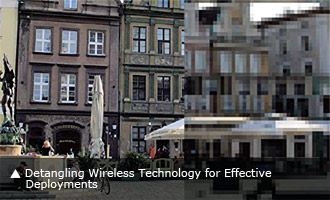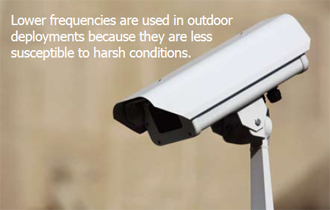The recent financial and economic climate has prompted the search for low-cost solutions while still delivering the same quality. Compared to wired transmission, wireless transmission can save tens of thousands of dollars per project on trenching, cabling and building remodeling.
The recent financial and economic climate has prompted the search for low-cost solutions while still delivering the same quality. Compared to wired transmission, wireless transmission can save tens of thousands of dollars per project on trenching, cabling and building remodeling.
 Wireless transmission has picked up speed over the past few years. Previously, wireless networks were used primarily for telecommunications and general Internet traffic, but the security industry has noticed their possibilities for growth and is enthusiastically deploying them in newer installations.
Wireless transmission has picked up speed over the past few years. Previously, wireless networks were used primarily for telecommunications and general Internet traffic, but the security industry has noticed their possibilities for growth and is enthusiastically deploying them in newer installations.
The greatest attribute of wireless transmission is its ability to negate wiring. “This means there is a lower cost of installation and easy maintenance,” said Parul Oswal, Industry Analyst, Frost & Sullivan. “It also gives users flexibility and ease in installing and moving cameras, remote accessibility to real-time video, and customization and integration with other features.”
 “There are many large deployments all over the world,” said Geoffrey Smith, Senior VP of Sales for the Americas, Europe and Africa, Proxim Wireless. “Only two years ago, companies had to spend a lot more time educating customers. Now, people have a better understanding of the technology and they realize that it works.” The percentage in video surveillance deployments has grown drastically due to increased awareness. “In terms of new installations,only 10 percent relied on wireless transmission back in 2008. These have grown to an estimated 50 percent in 2010.”
“There are many large deployments all over the world,” said Geoffrey Smith, Senior VP of Sales for the Americas, Europe and Africa, Proxim Wireless. “Only two years ago, companies had to spend a lot more time educating customers. Now, people have a better understanding of the technology and they realize that it works.” The percentage in video surveillance deployments has grown drastically due to increased awareness. “In terms of new installations,only 10 percent relied on wireless transmission back in 2008. These have grown to an estimated 50 percent in 2010.”
SMALL-SCALE PROJECTS
A smaller installation usually consists of fewer than 10 network cameras, with additional signals from intrusion and access systems which do not generate much data to be transmitted. “Wireless is ideal for a home, SOHO or SMB, since wires cause clutter and cabling pains and are not aesthetically appealing,” Smith said. “Such installations do not require wide coverage and are simple. Wireless nodes are connected to the gateway, which in turn is connected to the computer and Internet. Connecting to the Internet allows for remote access, which is very appealing.”
 The public have become very familiar with Wi-Fi, and it is common to find it in a majority of homes. Proprietary devices, such as gateways, can be used to allow communication up to certain distances between smaller wireless devices in a home environment. However, Wi-Fi is not optimal for video deployments. “Wi-Fi would encounter interference, resulting in dropped frames. Each camera can require up to 10 megabits (Mb) of bandwidth,” Smith said. “Wi-Fi can support up to three low-resolution cameras in an indoor development but falls apart when HD cameras are added.”
The public have become very familiar with Wi-Fi, and it is common to find it in a majority of homes. Proprietary devices, such as gateways, can be used to allow communication up to certain distances between smaller wireless devices in a home environment. However, Wi-Fi is not optimal for video deployments. “Wi-Fi would encounter interference, resulting in dropped frames. Each camera can require up to 10 megabits (Mb) of bandwidth,” Smith said. “Wi-Fi can support up to three low-resolution cameras in an indoor development but falls apart when HD cameras are added.”
Residential or SMB projects that require more bandwidth use access points. “Access points that look like smoke detectors are attached onto the ceiling, and they serve various Wi-Fi enabled clients such as laptops, smartphones and iPads,” said Walt Shaw, Senior Product Line Manager, Wireless Networking Business Unit, Cisco Systems. These are then connected to the LAN for integration.
 Since most small integrations do not carry an abundant array of devices, the point-to-point (PtP) topology is used. “PtP is the most used wireless topology for security, and it is mostly used in residential and some smaller commercial projects,” said Michele Bonafede, Sales and Marketing Manager, VS Safety.
Since most small integrations do not carry an abundant array of devices, the point-to-point (PtP) topology is used. “PtP is the most used wireless topology for security, and it is mostly used in residential and some smaller commercial projects,” said Michele Bonafede, Sales and Marketing Manager, VS Safety.
In Europe, all security systems use 868 megahertz (MHz) for transmission . “ Priorto the development of the 868-MHz band 11 years ago, 433 MHz was used. Everything used to run on 433 MHz, such as remote-control toy cars and garage doors, which made the 433-MHz band a less secure frequency. The 868-MHz frequency is much narrower, which allows for less data but encounters less interference. In Greece, it is the frequency used for military purposes,” Bonafede said.
New frequencies are constantly being opened up for communications. “60 gigahertz (GHz) is now being used for a new standard for indoor connectivity called Wi-Gig, which will be used in residential installations for digital-video HDMI applications,” said Joe Schraml, VP of Marketing, BridgeWave Communications.
MEDIUM-SCALE PROJECTS
Medium-sized installations, such as a hotel or building complex, require larger bandwidth capabilities. “PtP and point-to-multipoint (PtMP) using Wi-Fi or other unlicensed transmission frequencies are probably the most appropriate for medium-sized projects — for both video surveillance only and integrated systems,” said Roy Cummings, Technical Support Manager, AMG Systems.
 The environment of the installation site determines the types of devices that can be deployed. “We're seeing more HD cameras implemented indoors, and 802.11n is the most suitable for this application because it can transmit at speeds up to 300 Mb per second (Mbps) on one frequency. If larger data packets need to be transmitted, an extra frequency band can be added and the two frequencies together can transmit up to 600 Mbps,” Shaw said.
The environment of the installation site determines the types of devices that can be deployed. “We're seeing more HD cameras implemented indoors, and 802.11n is the most suitable for this application because it can transmit at speeds up to 300 Mb per second (Mbps) on one frequency. If larger data packets need to be transmitted, an extra frequency band can be added and the two frequencies together can transmit up to 600 Mbps,” Shaw said.
For outdoor deployments, using a private, dedicated, licensed frequency may seem appealing, but it is not often done due to cost considerations. “There are benefits to licensing a frequency because you own the whole spectrum, but it can cost up to thousands of dollars and will require numerous approvals,” Shaw said.  “Most of the time, many frequencies are used to complete a system. For example in an outdoor mesh deployment, 2.4 GHz is used for access, and 5 GHz for the backhaul. 5 GHz doesn't meet much interference, so applying it to the backhaul is ideal because it is the most important ‘link' in a system. The lower the frequency, the less degradation of data occurs because it is less susceptible to harsh conditions.” Often, two frequencies are used — one for transmitting and one for receiving — to reduce the clutter running on one band. Both 2.4 and 5 GHz are unlicensed, making them accessible to anyone.
“Most of the time, many frequencies are used to complete a system. For example in an outdoor mesh deployment, 2.4 GHz is used for access, and 5 GHz for the backhaul. 5 GHz doesn't meet much interference, so applying it to the backhaul is ideal because it is the most important ‘link' in a system. The lower the frequency, the less degradation of data occurs because it is less susceptible to harsh conditions.” Often, two frequencies are used — one for transmitting and one for receiving — to reduce the clutter running on one band. Both 2.4 and 5 GHz are unlicensed, making them accessible to anyone.
The double-frequency technique is also used for larger files requiring longertrans mission times. “Bandwidth limitations mean all data needs to be compacted, but even so, wireless still takes longer to transmit. To have a system that sends and responds quickly during an event, two different frequencies are used here in Europe. The 868-MHz frequency is used to transmit intrusion detection data first so that it may be immediately responded to, and video is sent on the 2.4-GHz frequency at a slower pace due to its file size,” Bonafede said. “Webcams can use the GSM network to transmit data in real time, but they are not usually used in mid-sized installations.”
LARGE-SCALE PROJECTS
 Larger integration projects, such as city surveillance, would consist of many different types of products running on different frequencies and topologies. “The most appropriate technology for large-scale applications would be mesh due to its ability to reconfigure a large number of cameras to changing requirements using WiMAX or an extension to WiMAX,” Cummings said.
Larger integration projects, such as city surveillance, would consist of many different types of products running on different frequencies and topologies. “The most appropriate technology for large-scale applications would be mesh due to its ability to reconfigure a large number of cameras to changing requirements using WiMAX or an extension to WiMAX,” Cummings said.
A mesh network forms a data transmission grid over a large area, and is optimal for medium-sized integrations as well as large integrations. “Mesh networks automatically adjust to topology changes. Nodes can be added, removed, replaced or relocated without the need for traditional network administration. Mesh networks can optimize or increase the visibility of dynamic systems, such as the environmental conditions inside of a commercial building or the conditions of machinery in a manufacturing plant, without the cost and administration of a wired network,” said Benno Ritter, VP of Marketing and Business Development, ZigBee Alliance.
Being able to use many different frequencies opens up device selections, but it could also mean higher cost. “For some systems, it is possible to integrate several frequencies, but the cost becomes 50 to 70 percent higher,” said Patrick Lim, Sales and Marketing Director, Ademco Far East.
 In the outdoor space, 60 GHz has been used over the last few years to provide high-capacity gigabit connectivity for enterprise, government and service provider users. Not all frequencies are made the same. “For dense, urban applications where a lot of data needs to travel short distances of 1 to 3 kilometers, 60- to 80-GHz transmissions are ideal. In urban areas, cameras can be mounted on light poles or sides of buildings and backhauled to a control center using 60 to 80 GHz gigabit links,” Schraml said.
In the outdoor space, 60 GHz has been used over the last few years to provide high-capacity gigabit connectivity for enterprise, government and service provider users. Not all frequencies are made the same. “For dense, urban applications where a lot of data needs to travel short distances of 1 to 3 kilometers, 60- to 80-GHz transmissions are ideal. In urban areas, cameras can be mounted on light poles or sides of buildings and backhauled to a control center using 60 to 80 GHz gigabit links,” Schraml said.
The most appealing aspect of the mesh topology is its ability to provide redundancy. “Some mesh options are intelligent enough to select up to eight different routes to send back a signal,” Lim said. He warns, however, that total redundancy for wireless video transmission is seldom considered, as it requires costly duplication of equipment and infrastructure.
 It is critical for outdoor deployments to have a good line of sight (LoS) for data to be carried across long distances smoothly. “Antennas are placed high on top of buildings so that the transmission can avoid running into as many physical objects as possible, which can cause interference,” Shaw said. Objects such as mirrors, cement and so forth can degrade wireless signals.
It is critical for outdoor deployments to have a good line of sight (LoS) for data to be carried across long distances smoothly. “Antennas are placed high on top of buildings so that the transmission can avoid running into as many physical objects as possible, which can cause interference,” Shaw said. Objects such as mirrors, cement and so forth can degrade wireless signals.
Wireless video is very popular and can help reduce cabling cost in temporary large events, and it can also act as an extension to existing surveillance systems that have a direct LoS, Lim added.
MEGAPIXEL AND HD NEEDS
Megapixel and HD cameras are becoming more popular as users realize the need for usable images in the event of a crime. Different bandwidth capabilities and wireless applications have their own limitations, and not all are suitable for transmitting large image files from megapixel and HD cameras. “The volume of data produced by megapixel and HD cameras place more stress on the wireless network. This can be coped with by integrating more links, thus effectively increasing the size of the network. Potentially, this could mean using a separate  link per camera, which would of course increase the cost of the overall network,” Cummings said.
link per camera, which would of course increase the cost of the overall network,” Cummings said.
A single network video surveillance camera can transmit up to 5 Mbps, and 60- and 80-GHz frequencies have ample spectrum to allow the aggregation of multiple network video cameras f o r transmission to a central command center, Schraml said.
Naturally, implementing multiple network video cameras would require very large bandwidth, and one would consider using H.264 compression to decrease file size. This indicates that wireless transmission may not be the best approach for applications where image quality is of the utmost importance. “Compressed video signals always represent a trade-off between image quality and latency,” Cummings said. To set up a strong wireless system involving megapixel and HD cameras may cause much budget concern arising from the additional devices required to stabilize critical transmission.